Our Lady of the Assumption Cathedral National Historic Site
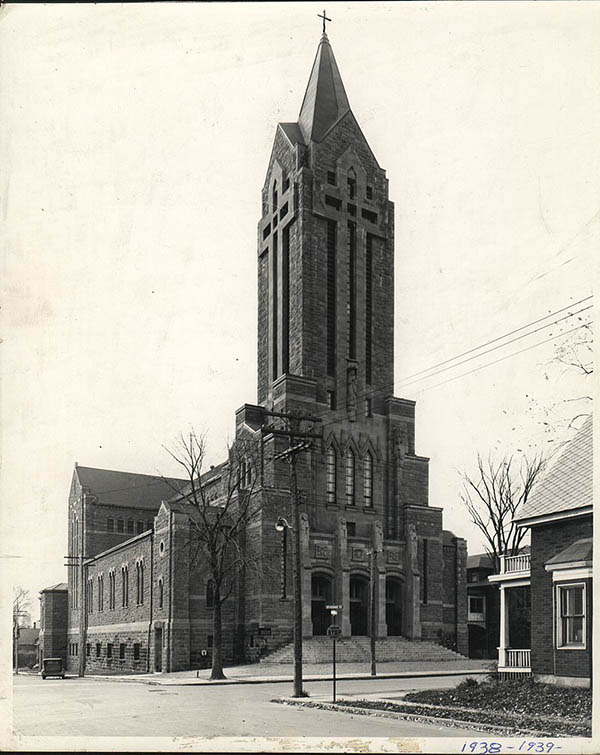
© Public domain / wikipedia commons
Our Lady of the Assumption Cathedral was designated a national historic site in 2017.
Commemorative plaque: 226 St. George Street, Moncton, Moncton, New BrunswickFootnote 1
Our Lady of the Assumption Cathedral
Built in 1939 and 1940, as the Monument of Remembrance, this cathedral is a symbol of the achievements and resilience of Acadians. It recounts their history in decorative elements, such as the tower sculpture of the Assumption of the Virgin Mary, patron saint of Acadie, capitals sculpted by Acadians, and stained glass windows depicting both secular and religious events in the history of Acadie. The exterior combines elements of Art Deco and Gothic Revival styles, while the interior is Romanesque. An affirmation of Acadian identity, the construction of this cathedral followed the creation of the Archdiocese of Moncton in 1936.
Our Lady of the Assumption Cathedral
Designed and built in 1939-1940, Our Lady of the Assumption Cathedral speaks to the history of the Acadian people. Decorative elements related to their religious and secular history are found throughout the cathedral; these include an exterior sculpture of the Virgin Mary, patron saint of the Acadians, and stained glass windows depicting significant religious and historical events. Its exterior architecture is an accomplished and eclectic blend of Gothic Revival and Art Deco styles, while the interior draws from the Romanesque style. Built to affirm the Acadian identity and pay tribute to their resilience, its construction mobilized the Acadian community and diaspora behind a project to erect the first large-scale building commemorating them as a distinct people. The cathedral is associated with the establishment of the Archdiocese of Moncton in 1937 and embodies the final phase of the Acadian Renaissance. This place of worship continues to be a tangible symbol of the achievements of Acadians throughout their history.
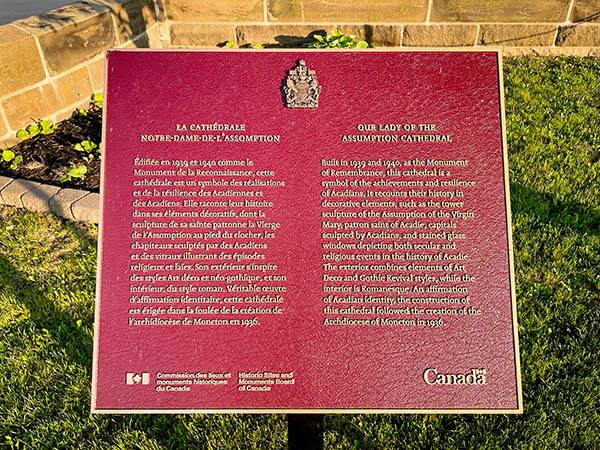
© Parks Canada / A. Audet
Built according to plans drafted by the architect Louis Napoléon Audet (1881-1971), the cathedral measures about 70 metres long by 43 metres wide. In addition to the church, the building includes two chapels, two sacristies, and many rooms located on multiple floors. Many of its decorative elements refer to the Acadian people and their history. Inside the church, the crowns (capitals) on the pillars facing the main altar were carved by Acadian craftspeople and depict objects associated with various trades practised by the Acadians throughout their history. The two large stained-glass windows in the cathedral transepts depict significant events in the religious and secular history of Acadia and its people.
Our Lady of the Assumption Cathedral is the physical manifestation of the culmination of decades of efforts by Acadians to win recognition for their presence, their demographic importance, and their legitimate rights as full citizens in the political, social, economic, cultural, and religious contexts of the Maritime provinces. The construction project was supported by Acadians in the archdiocese, the Maritime provinces, Quebec, Louisiana, and New England.
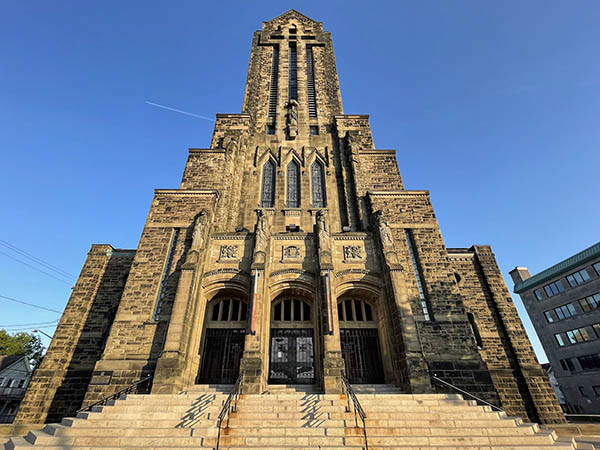
© Parks Canada / A. Audet
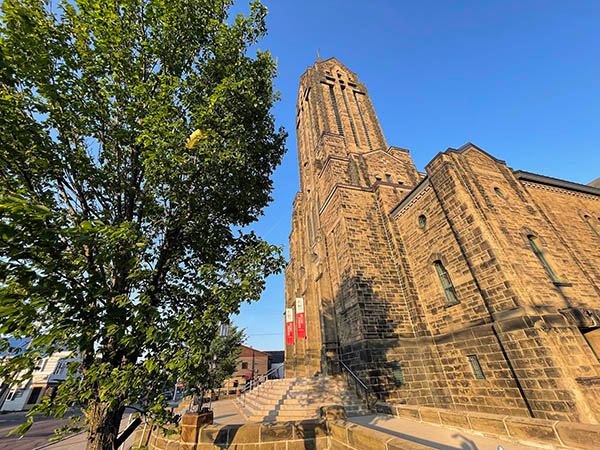
© Parks Canada / A. Audet
The cathedral stands on the former site of a crypt and unfinished chapel that was used as a place of worship in the first French-speaking parish in Moncton, which was itself born out of the breaking up of St. Bernard’s Parish in 1914. The cathedral is the achievement of this parish’s first archbishop, Mgr. Louis-Joseph-Arthur Melanson (1879-1941). Acadians in New Brunswick and the Maritime provinces consider it to be a crown jewel of their architectural heritage, and its historical and heritage value stems in large part from the associative and symbolic values conferred on it by the Acadian community.
This press backgrounder was prepared at the time of the Ministerial announcement in 2019.
Description of historic place
Notre-Dame de l'Assomption Cathedral National Historic Site of Canada stands in downtown Moncton, surrounded by private residences and commercial buildings. The building has several decorative elements referring to the Acadian people and their history. Official recognition refers to the footprint of the building at the time of designation.
Heritage value
Our Lady of the Assumption Cathedral was designated a National Historic Site of Canada in 2017. It is recognized for the following reasons:
- its exterior architecture is an accomplished and eclectic blend of Gothic Revival and Art Deco styles, while the interior draws from the Romanesque style. Designed and constructed in 1939-1940, it speaks to the history of the Acadian people in decorative elements found throughout the cathedral, including in the exterior sculpture of the Virgin Mary, patron saint of the Acadians, and stained glass windows depicting significant events in the religious and secular history of the Acadian people;
- built to affirm the Acadian identity and pay tribute to their resilience, its construction mobilized the Acadian community and diaspora behind a project to erect the first large-scale building commemorating them as a distinct people;
- associated with the Archdiocese of Moncton, and built shortly after its creation in 1937, the cathedral embodies the final phase of the Acadian renaissance. This place of worship continues to be a tangible symbol of the achievements of Acadians throughout their history.
Built primarily in 1939–1940, this sandstone cathedral is the mother church of the Archdiocese of Moncton. It is considered the great achievement of its first archbishop, Mgr. Louis-Joseph-Arthur Melanson (1879–1941). It stands on the former site of the crypt and unfinished chapel of Notre-Dame de l’Assomption that was used as a place of worship in the first French-speaking parish in Moncton, itself born out of the dismemberment of St. Bernard’s Parish in 1914.
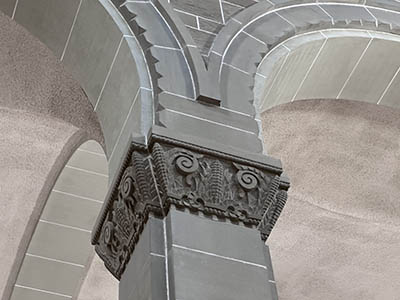
© Image courtesy of the Monument for Recognition in the 21st century (MR21)
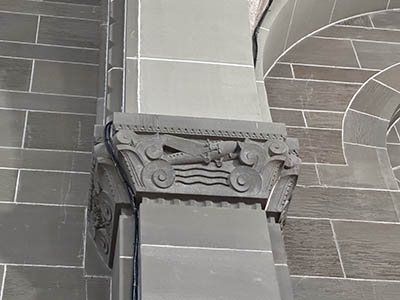
© Image courtesy of the Monument for Recognition in the 21st century (MR21)
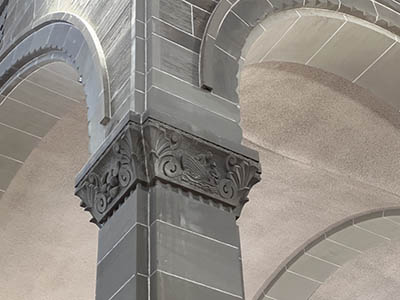
© Image courtesy of the Monument for Recognition in the 21st century (MR21)
Our Lady of the Assumption Cathedral, Episcopal and parish church, continues to serve as a place of religious worship (Roman Catholic) to this day. The integrity of its design, materials and execution has been maintained, despite some renovations in recent decades. The church has retained its original form and almost all of its original materials (olive sandstone from Shediac, tiles from Belgium, marble from Italy and onyx from Brazil) and the main decorative elements of the interior (sculptures, stained glass windows, murals, etc.).
The symbolic value of the cathedral stems from the fact that it is a tangible symbol of the achievements of the Acadians throughout their history and it was built to affirm the Acadian identity and embodies the Acadian Renaissance that began in the previous century.
Source: Historic Sites and Monuments Board of Canada, Minutes, December 2015.
The National Program of Historical Commemoration relies on the participation of Canadians in the identification of places, events and persons of national historic significance. Any member of the public can nominate a topic for consideration by the Historic Sites and Monuments Board of Canada.
- Date modified :